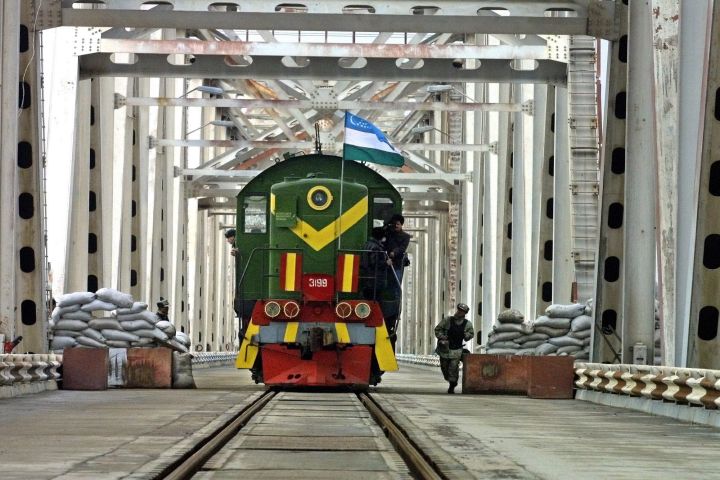
US, Chinese Plans for Rail Links with Central Asia Triggering ‘Railroad War’ and Reducing Russia’s Influence
Publication: Eurasia Daily Monitor Volume: 10 Issue: 31
By:

United States plans to link the countries of Central Asia by new rail lines with Afghanistan. At the same time, Washington opposes neither the construction of a railway corridor from Central Asia through Iran, nor Chinese extensions of its national rail system into the area. Nevertheless, according to analysts at the Moscow Strategic Culture Foundation, these overlapping transportation development projects threaten to spark a new “railroad war” in the Central Asian region—one that in the absence of counter-efforts by the Russian Federation is likely to result in a sharp reduction of Moscow’s influence over the countries there.
Washington’s plan is the most far-reaching, at least immediately, the Foundation suggests. According to the just-released quarterly report prepared by the US special inspector for reconstruction projects in Afghanistan, the United States is currently promoting the creating of a new railway network in that country, one that will link with the national railroad systems of Uzbekistan, Tajikistan and Turkmenistan. These countries will, as a result, be able for the first time to ship their products through the Iranian port of Bandar-Abbas via a corridor that, in the words of the report, “will be free from Russian influence” (www.fondsk.ru/news/2013/02/16/relsovaya-voyna-vashingtona-v-afganistane-i-centralnoj-azii-19153.html; www.fondsk.ru/news/2013/02/14/myshelovka-dlja-centralnoj-azii-19132.html),
The US-backed Central Asia Regional Economic Cooperation effort calls for the construction of approximately 2,000 kilometers of new railways in Afghanistan, a project to be paid for by the Asian Development Bank, the United Nations, the World Bank and the International Monetary Fund, as well as by contributions from interested neighboring countries such as India and Pakistan.
A year ago, the Moscow foundation continues, the leaders of Tajikistan, Afghanistan and Iran agreed on the need for cooperation in order to accelerate the construction of a railroad from Iran to Tajikistan through Afghanistan, according to Western news reports. And Washington reportedly approved “this initiative” because it fits in with the US “Silk Road” program and reinforces the Northern Distribution Network (NDN) that North Atlantic Treaty Organization (NATO) forces have been using as a supply route to Afghanistan. But given Washington’s attitude toward Tehran, the United States is not interested in helping the Iranians extend their influence into Central Asia by opening its rail lines and ports to the countries of that region. Instead, the Foundation’s analysts suggest, the US has a broader and, from Moscow’s point of view, more threatening purpose: “to cut off Central Asia from Russia in the transportation and communication sectors.”
That conclusion is suggested as well by the US reaction to Beijing’s plans to link the Central Asian countries with China’s national rail system. The United States is not opposing those, and if China succeeds in building these lines, Russia will face a serious challenge to its standing there. Mikhail Chernov, the special representative of the Association for Trans-Border Cooperation in Central Asia and the Caucasus, told the Moscow Strategic Culture Foundation that this combination “will reform the entire region,” and in ways that are highly threatening primarily to the Central Asian republics. According to him, drug traffic will increase, as will the influx of radical Islamic groups.
In Soviet times, Chernov continues, “the borders were closed and automobile and rail links were absent… Now, the situation is objectively changing. The region is opening up, the process cannot be stopped, and this is a good thing” as long as Russia is a participant in it rather than the target of a geopolitical project by others. Everyone will benefit, he argues, if Russia more tightly links its railway system with Central Asia and links into the railway network of Pakistan.
The Foundation analysts suggest that the leaders of the Central Asian countries have not made any final decisions about this project, an indication that Russian diplomats may seek to dissuade them from cooperating with the United States and China. Tajikistan appears to be most committed to the idea, with Uzbekistan somewhat less so, the analysts say. And the Kyrgyz Republic’s position is far from clear. Some in Kyrgyzstan fear that Bishkek could lose more than it would gain.
That is because, the Moscow foundation analysts say, China is unlikely to spend as much as it plans without being able to reap the benefits of control over raw materials in Kyrgyzstan and other Central Asian countries. Toktogul Kakchekeyev, a Bishkek security analyst, argues that China and the United States are already cooperating to a certain extent, a clear indication in his mind that the two are working against Russian interests in the region. “For the Americans,” he insists, “a railway network in Afghanistan is a political instrument for isolating Central Asia from Russia.” To counter that, he suggests, Moscow must develop its own rail links with the region.
If these various rail projects are begun, they could very well launch a new “railway war” in Central Asia, one that is likely to be bitterly fought because the geopolitical consequences of new railroads may be even greater than those arising from new pipelines.




